Parking garage lighting plays a crucial role in safety and efficiency. At PacLights, we’ve seen firsthand how motion sensors can transform these spaces.
Parking garage lighting motion sensors offer a range of benefits, from enhancing security to reducing energy costs. In this post, we’ll explore why this technology is becoming a must-have for modern parking facilities.
How Motion Sensors Enhance Parking Garage Safety
Motion-activated lighting in parking garages revolutionizes safety. The National Safety Council reports that inadequate lighting contributes to pedestrian accidents in parking lots. Motion sensor technology significantly reduces this risk.
Improved Visibility for All Users
Motion sensors trigger lights to brighten when they detect movement, instantly improving visibility. This proves essential in areas like stairwells and corners where accidents occur more frequently. The Illuminating Engineering Society recommends a minimum of 5 foot-candles for general parking areas (easily achievable with motion-activated LED lighting).
Elimination of Dark Spots and Crime Deterrence
Dark areas in parking garages provide potential hiding spots for criminals. Motion-activated lighting eliminates these dark spots, making it difficult for wrongdoers to conceal themselves. Studies show that well-lit parking facilities experience a 30% decrease in crime rates compared to poorly lit ones. This dramatic reduction in criminal activity creates a safer environment for both drivers and pedestrians.
Rapid Security Response
Motion-activated lighting integrates with security systems, alerting personnel to unexpected movement in the garage. This integration allows for faster response times to potential security threats. Some advanced systems even trigger security cameras to start recording when they detect motion, providing valuable evidence if needed.
Energy Efficiency and Cost Savings
Motion sensor lighting not only enhances safety but also reduces energy consumption. Lights activate only when necessary, leading to significant energy savings (up to 75% in some cases). This efficiency translates to lower operational costs for garage owners and a reduced carbon footprint.
Customizable Solutions for Diverse Needs
Modern motion sensor systems offer customizable settings to suit different parking garage layouts and usage patterns. Operators can adjust sensitivity levels, illumination duration, and coverage areas to optimize both safety and energy efficiency. This flexibility ensures that the lighting system adapts to the unique needs of each parking facility.
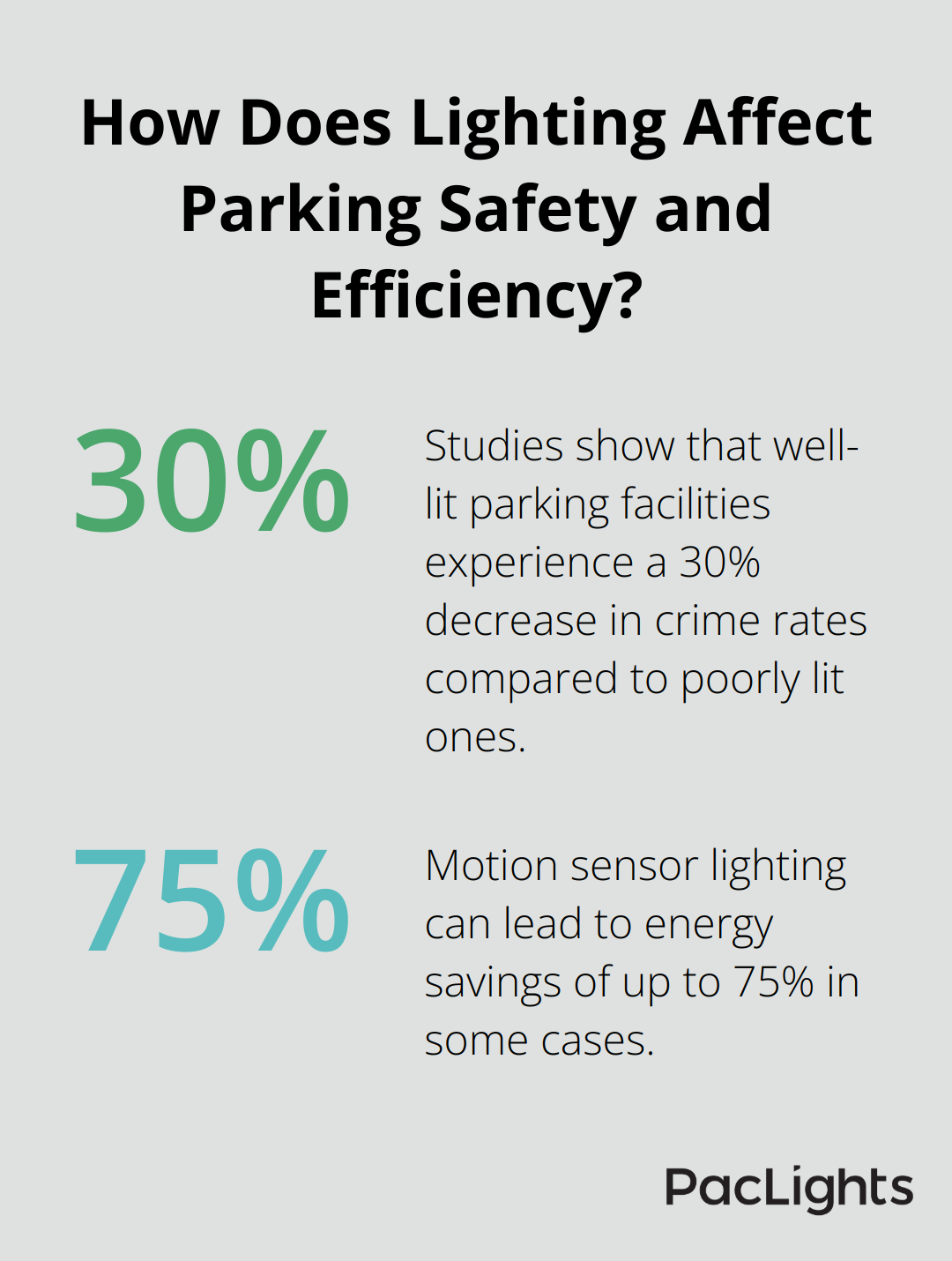
As we move forward, let’s explore how these safety enhancements translate into tangible energy efficiency and cost savings for parking garage operators.
How Motion Sensors Slash Energy Costs in Parking Garages
Motion sensor lighting in parking garages transforms both safety and financial outcomes. This technology proves to be a smart investment for garage operators, offering substantial energy savings and cost reductions.
Dramatic Energy Consumption Reduction
The occupancy controls reduced the energy used by the new LED system by 76%, but the additional savings relative to the original HID system in parking garages were even more significant. Motion sensors eliminate waste by activating lights only when needed.
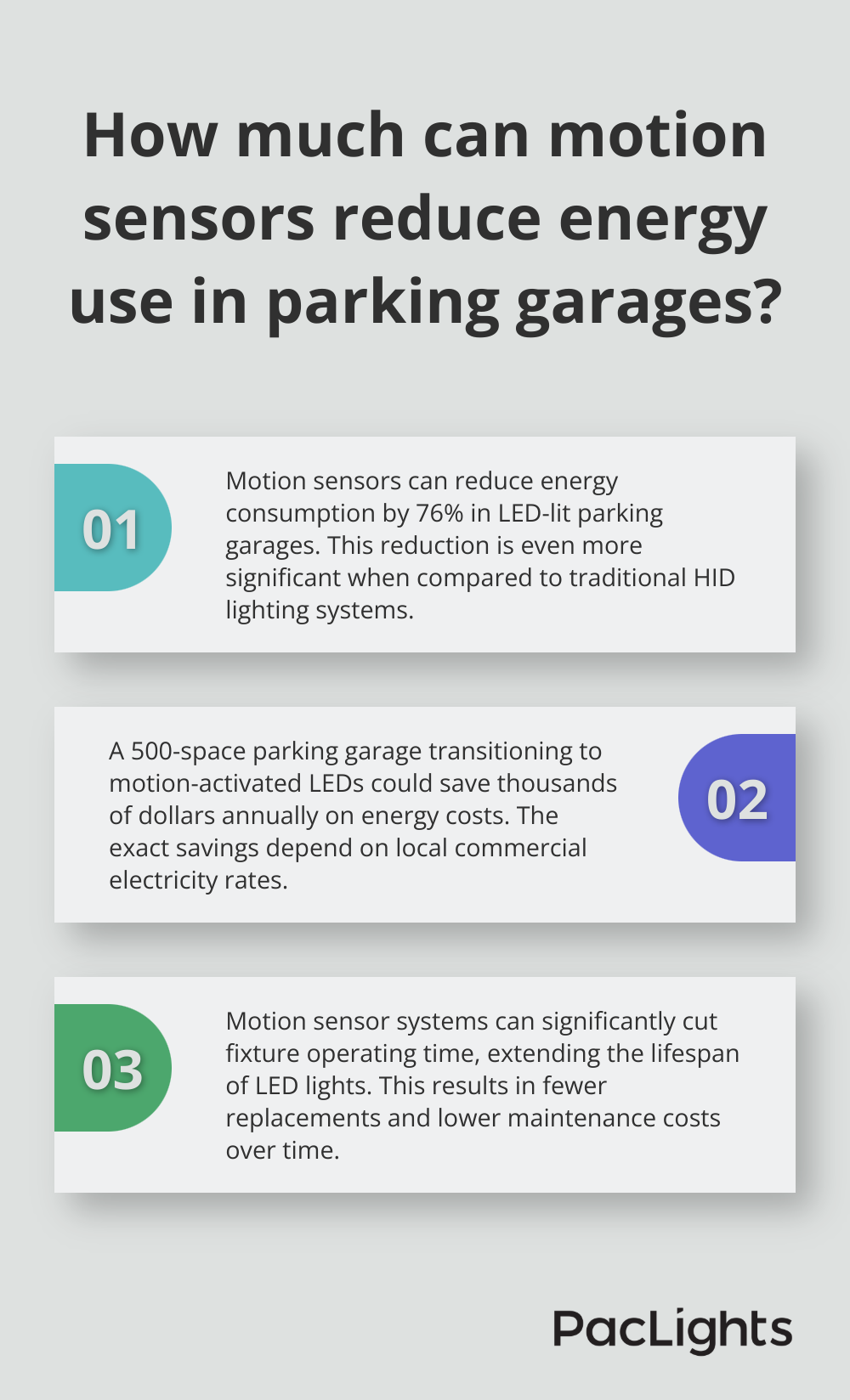
Consider a 500-space parking garage that transitions from constant lighting to motion-activated LEDs. This facility could achieve significant annual energy savings. At an average commercial electricity rate, the garage operator could save thousands of dollars each year on energy costs alone.
Extended Fixture Lifespan
Motion sensors not only save energy but also prolong the life of lighting fixtures. These systems can extend the lifespan of LED lights by reducing operating hours. This results in fewer replacements and lower maintenance costs over time.
A study revealed that motion sensor systems can cut fixture operating time significantly, depending on the area’s traffic patterns. For garage owners, this translates to savings on replacement costs and maintenance labor.
Rebates and Incentives Boost ROI
Many utility companies and government agencies offer rebates and incentives for energy-efficient lighting upgrades. These programs offset initial installation costs, making the switch to motion sensor lighting even more attractive.
Various programs across the U.S. offer rebates, which can cover a portion of upgrade costs.
Real-World Savings
Clients who invest in motion sensor lighting systems often recoup their investment within a few years through energy savings and reduced maintenance needs. After this period, the continued savings contribute directly to the bottom line, making this technology a clear choice for forward-thinking garage operators.
As we explore the implementation of motion sensor lighting, it’s essential to understand the various types of sensors and their optimal placement for maximum efficiency and effectiveness.
How to Implement Motion Sensor Lighting in Parking Garages
Choosing the Right Motion Sensors
The selection of appropriate motion sensors is essential for optimal performance in parking garages. We recommend using passive infrared (PIR) sensors or microwave sensors. PIR sensors detect heat changes from moving objects, while microwave sensors use radio waves to detect motion.
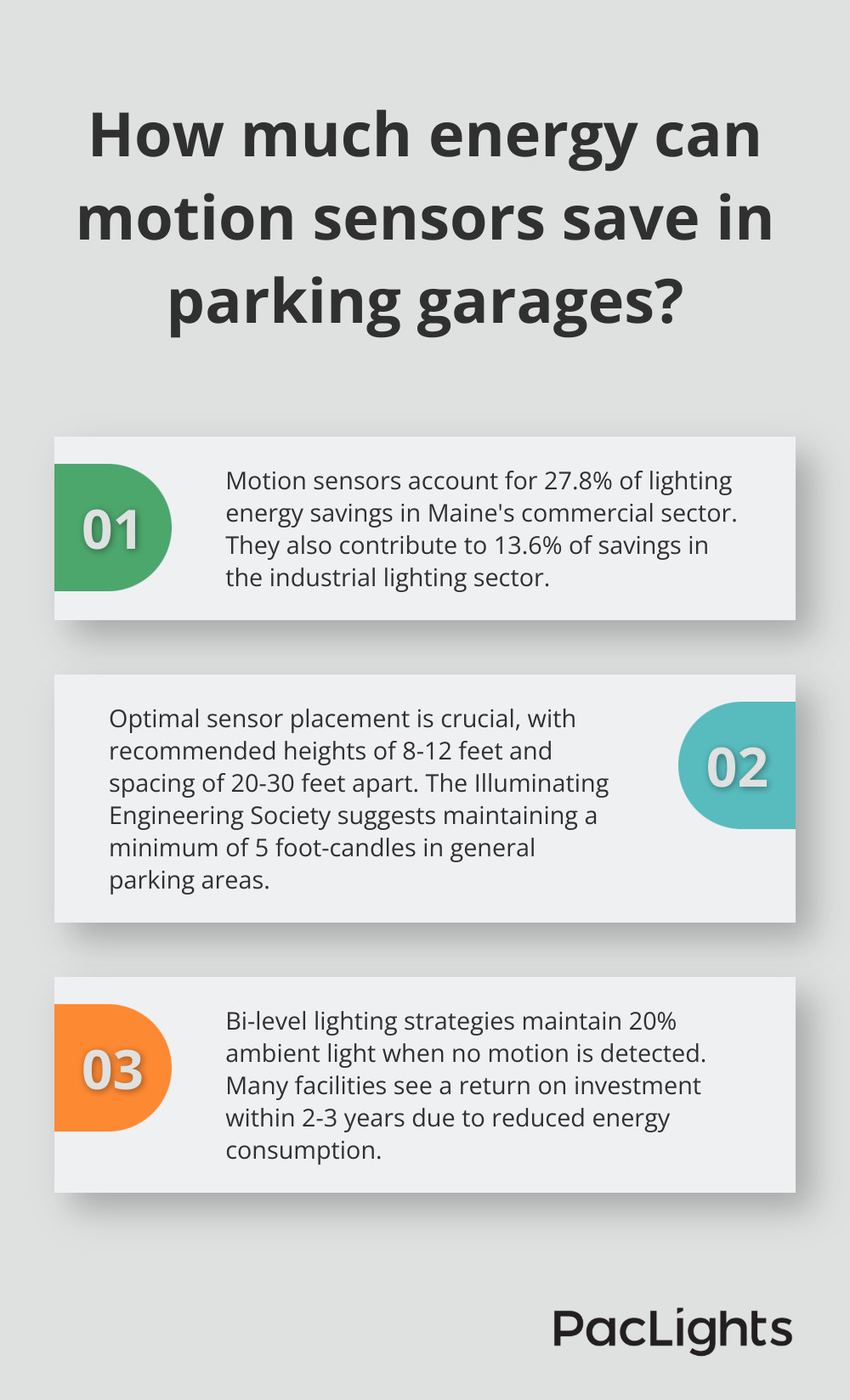
PIR sensors excel in smaller areas like stairwells or individual parking spots. Microwave sensors suit larger open spaces due to their wider detection range. Some parking garage operators prefer dual-technology sensors, which combine both PIR and microwave technologies for increased accuracy and reduced false triggers.
Occupancy sensors account for 27.8% of lighting energy savings potential in the Maine commercial sector and 13.6% of the industrial lighting sector.
Strategic Sensor and Fixture Placement
The optimal placement of sensors and fixtures is key to achieving maximum efficiency and coverage. Install sensors at entry and exit points, near elevators, and in stairwells to ensure immediate illumination when users enter these high-traffic areas.
For open parking areas, mount sensors on light fixtures or walls at a height of 8 to 12 feet. This height range provides good coverage while minimizing false triggers from vehicle exhaust or small animals. Space sensors approximately 20 to 30 feet apart to ensure complete coverage without gaps.
The Illuminating Engineering Society recommends maintaining a minimum of 5 foot-candles in general parking areas. Your sensor placement and light fixture distribution should meet or exceed this standard for optimal safety and visibility.
Integration with Existing Systems
The integration of motion sensor lighting with existing control systems can further enhance efficiency and user experience. Many modern parking garages use centralized lighting control systems that can easily incorporate motion sensor technology.
When integrating motion sensors, consider implementing a bi-level lighting strategy. This approach maintains a low level of ambient light (around 20% of full output) when no motion is detected, then ramps up to full brightness when sensors are triggered. This strategy balances energy savings with user comfort and safety.
Some advanced systems allow for data collection and analysis. These systems can track occupancy patterns, helping garage operators optimize lighting schedules and sensor sensitivity over time.
The initial cost of implementing motion sensor lighting can vary depending on the size and complexity of the parking garage. However, many facilities see a return on investment within 2-3 years due to reduced energy consumption and lower maintenance costs.
Customization and Fine-Tuning
After installation, it’s important to customize and fine-tune the motion sensor lighting system. This process involves adjusting sensitivity levels, time delays, and coverage areas to match the specific needs of your parking garage.
Try to set time delays (the period lights remain on after motion is no longer detected) to balance energy savings and user comfort. Typical time delays range from 5 to 15 minutes, depending on the area and usage patterns.
Regular monitoring and adjustment of the system will ensure optimal performance over time. This may include seasonal adjustments to account for changes in daylight hours or modifications based on usage data collected by the system.
Motion sensor lighting in parking garages improves safety and efficiency. These systems enhance visibility for drivers and pedestrians while deterring criminal activity. The elimination of dark spots and rapid security response capabilities create a safer environment for all garage users.
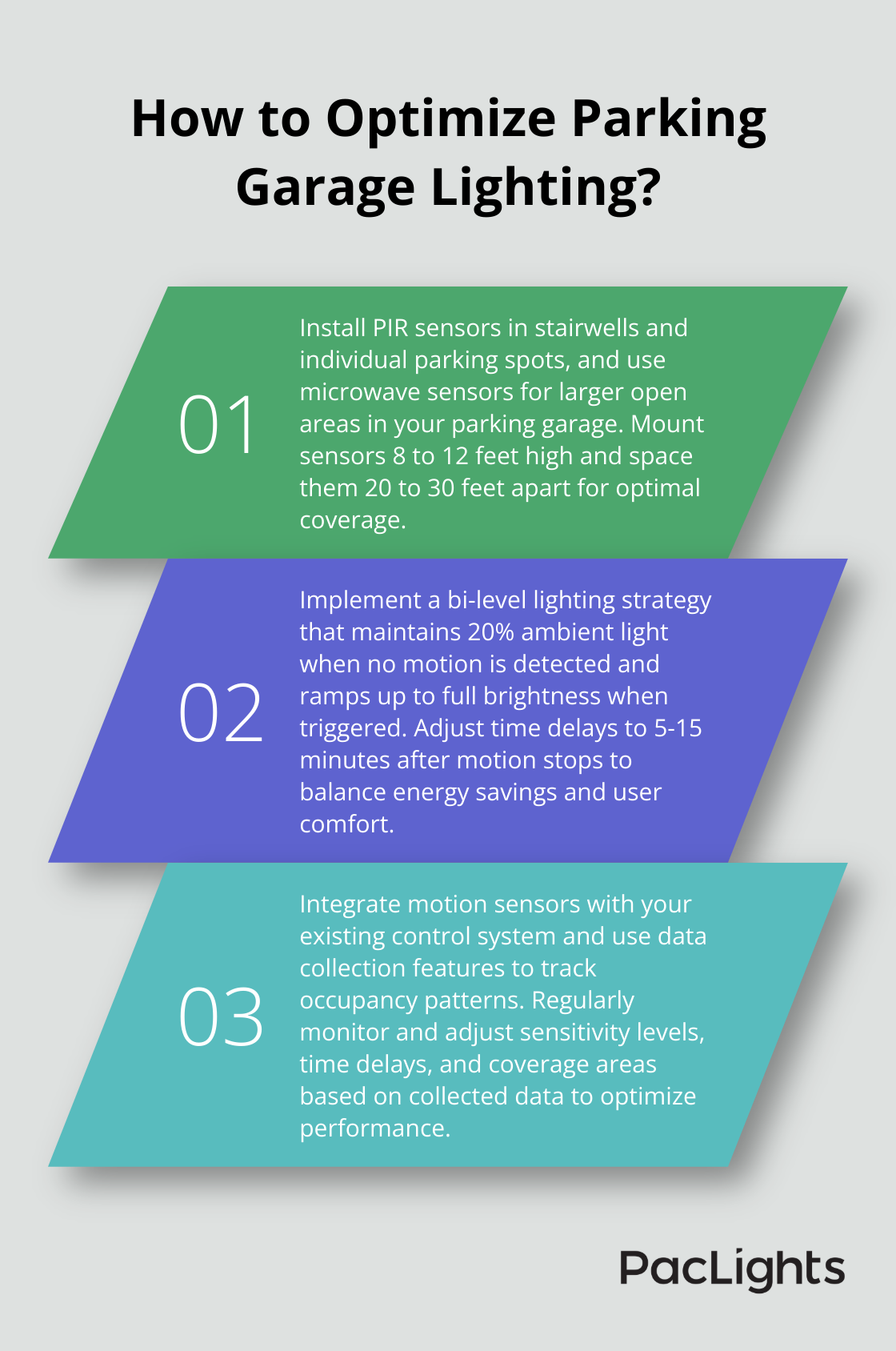
Parking garage lighting motion sensors offer substantial energy-saving potential. Garage operators can see a noticeable decrease in operational costs with reductions in energy consumption of up to 75%. The extended lifespan of fixtures and reduced maintenance needs further contribute to long-term savings.
Professional installation and ongoing maintenance unlock the full potential of motion sensor lighting systems. PacLights offers a comprehensive range of lighting solutions tailored to diverse industrial needs, including parking garage applications. Our expertise in energy-efficient lighting, combined with advanced control options like motion sensors, ensures that your parking facility benefits from cutting-edge technology.


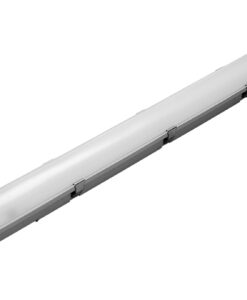
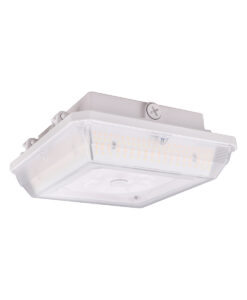
Disclaimer: PacLights is not responsible for any actions taken based on the suggestions and information provided in this article, and readers should consult local building and electrical codes for proper guidance.